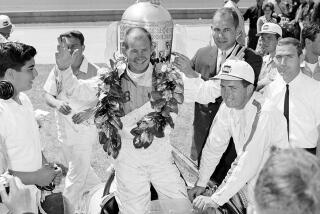FIXATIONS Auto Manic : * Mark Woods of Fountain Valley lives for early ‘60s Chryslers. He’s driven by the ideal of the America they represented.
- Share via
A few years back I was working at a newspaper where we could scarcely contain our anticipation when one of the “star” feature writers took an infrequent stab at hard-news investigative reporting, which in his case meant going out and reviewing a new muscle car.
Invariably, amid his ad-copy-like prose about the vehicle’s sexy lines and lumbar support system, he would, in all earnestness, drop in the phrase: “And power? This baby’s got it!”
This was a constant source of mirth to the rest of us, and some small solace now that the writer has parlayed those descriptive skills into a megabuck novel and film career, leaving the rest of us behind in a spray of gravel and exhaust from his fleet of muscle cars.
But how much power do those babies really have? Since I’m never likely to own one, I’m inclined to think these new models don’t amount to squat. They may accelerate like a road runner, but they’re still about as substantial as the chocolate shell that wraps around an M&M.;
Consider instead the 1961 Chrysler 300, a vehicle that could scarcely have weighed more if it had been made out of cinder blocks. Its speedometer went to 150, and meant it.
Mark Woods of Fountain Valley thinks a lot about old Chryslers. That’s when he’s not busy buying them, reassembling them, driving or displaying them at car shows. At one point the 26-year-old had 16 early ‘60s Chryslers, mostly 300s and New Yorkers.
When he lights a cigarette, it’s with a vintage Chrysler lighter, and it goes into a Chrysler dealership ashtray. When his phone rings, he typically answers, “Mopar Central,” Mopar being the name of Chrysler’s line of replacement parts.
His Chrysler consciousness began a decade ago when he was driving with some girlfriends on the Costa Mesa and Garden Grove freeways. Woods didn’t like new cars and was tired of the ‘50s Chevies and Caddies his rockabilly friends were driving.
“I had a ’67 BMW at the time, and this turquoise blur just goes by, wvrwuuuuggm , and we go, ‘What was that!’ I’d never seen anything like it. I was probably doing 90 trying to catch up with this guy, and only did miles later in Costa Mesa because the freeway ended and he had to stop for a signal.
“He had a ‘for sale’ sign (on the window) and I honked to pull him over. And I couldn’t believe what I was seeing. I mean, you open the door, push a button and seats swivel out? What is that ? Then those fins? The push-button transmission? Then the dash gleams . It doesn’t have light bulbs--it’s this electro-luminescent lighting that glows, in this dash that looks like it’s from the Buck Rogers school of engineering.”
After “not being able to breathe or talk or think or anything” while looking it over, Woods figured he needed the car, a ’61 New Yorker, if he was to go on living. He wanted it enough to pester the owner down from $2,200 to the $800 he could afford, and he was off. Now, he says, “if there’s ever a time when none of my cars is running, I don’t feel normal. When I get home from work in a lowdown mood, I start the car up and go driving, and it makes everything all right.”
Chrysler may have been the smallest of the Big Three auto makers, but it seems to have been undaunted by its market status. In the golden years between 1957 and 1964, everything from its stubby little Valiants to the immense Imperial was a masterful blend of grace and gonzo. The designs had sweeping lines and curves, fins that made Cadillacs look lame and front grills so whimsical that if a Chrysler ran you down, your corpse would probably be grinning.
And there was none of this “1.5 liter” tweak-head nonsense under the hood, just big loutish engines, one of which the company modestly named the Golden SonoRamic Commando.
Once Woods was driving six of his friends home from a late-night blues show in Riverside in one of his New Yorkers--considered a family car, its speedometer only went up to 120--when he saw some headlights coming up behind him:
“We were probably cruising at about 110 m.p.h., but I could see from the little headlights that it wasn’t a cop. I figured I’d speed up a little bit, and he’s still coming up pretty good. He never really caught up, so I slowed down to see what it was, and it turned out to be one of the newer Jag convertibles. As soon as I saw what it was, I figured it was going to be a little bit of a challenge session.
“Everybody else was sleeping, so I figured they wouldn’t even know. I punched it, and my speedometer topped out and was starting to bounce back and forth and go crazy. Finally it just blew, and you heard all these gears making all these weird noises and it woke everybody up, going ‘Whaa??!’ because we were going whhoooooooough down the 91, with this Jag trying to get up to it.
“He never did.”
It should be noted here that the one area in which Woods feels old Chryslers to be lacking is the brake system.
Needless to say, Woods is of the belief that vintage cars are meant to be driven.
“I’ve been working on a car for seven years, doing a complete frame-off restoration, taking the whole thing apart to nothing. And it’s perfect, spotless, now. People think it should be in my living room, but I want to drive it and have fun with it.
“One thing I can’t appreciate are these people who only trailer their cars to the shows, and don’t drive them. I think if you’ve got the money to own it, you’ve got the money to fix it, and it should be driven. You ought to be driving the car so other people can enjoy it too.”
Woods avers that he always obeys traffic laws these days. He sold off the majority of his cars awhile back to buy a house, except for the ’63 Imperial convertible and New Yorker in the back yard and various other Batmobile shapes parked out front.
He once rented out auto shop space to work on all his cars but now does it in his garage. Having fewer cars hasn’t lessened his involvement with them. His idea of a two-week vacation this past summer?: “I told my girlfriend not to talk to me, not to look at me, ‘I’m sorry but I’m going to be in the garage working on my car.’ And that’s what I did, getting more done in two weeks than I had in two years.”
Having been born long after his cars were made, his passion for them isn’t fueled by a direct nostalgia, he said, but from an ideal of the America they represented.
“What these cars tell me is people used to really care about what they did. A cheap thing from 40 years ago is sometimes better than the top-of-the-line thing today. People were craftsmen, and they used that extra personal touch to make sure things got done right.
“And they had character, styling. These days all the cars look the same. I’m kind of a character, and I like the cars that have a lot of character.”






